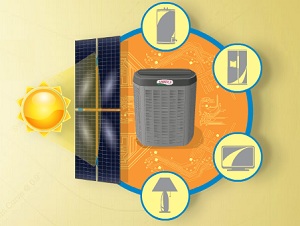New solar-integrated HVAC system released
 An HVAC system that directly integrates with solar power has the potential to dramatically reduce energy bills and cut back on carbon emissions. That’s why Lennox Industries released the first solar-integrated heating and cooling system earlier this month.
An HVAC system that directly integrates with solar power has the potential to dramatically reduce energy bills and cut back on carbon emissions. That’s why Lennox Industries released the first solar-integrated heating and cooling system earlier this month.
Reports have shown that heating and cooling are the primary draws on power and the most costly part of utility bills for businesses and homeowners.
Lennox’s new SunSource Commercial Energy System addresses that issue directly, by tying solar panels directly in with its heating and cooling system.
The SunSource provides a simple solution that doesn’t require a lot of retrofitting, said Larry Wei, product manager for Lennox Industries.
“Customers purchase a solar-ready Energence rooftop unit equipped to integrate with our solar-module assemblies,” Wei said. “The solar-module assemblies feature plug-and-play wiring and integrated microinverters, and require 80 percent fewer parts to install than traditional solar-power systems. Also, Lennox’s SunSource system typically will not require any modifications to the building’s electrical infrastructure, making it easier to install than traditional solar systems.”
Each solar-ready Energence roof can handle up to 21 solar panels, Wei said. Depending on how much energy is needed to heat the building, that’s usually enough to provide all the power needed to the heating and cooling system.
If the system produces more solar electric power than needed for climate control, it will feed into the building’s general electric supply or back onto the utility’s electric grid, according to product information.
The microinverters that direct the solar panels’ power, know where to send it when and to turn off in the event of a grid power outage.
Customers can install as many solar modules as they want up to the 21, so they can reduce the cost of the system by buying fewer, especially if they don’t need a large system to cover their heating and cooling expenses.
“The average payback time is heavily dependent on usage profile and the incentives available in each state or region,” Wei said. “In certain cases, up to 85 percent of the first cost of a system can be covered by rebates and incentives.”
He said one of the benefits of the system, especially to a business, is that the sun is out during the time of day when companies most need to control the climates inside their buildings, helping with their peak demand.
Image courtesy of Lennox Industries.



